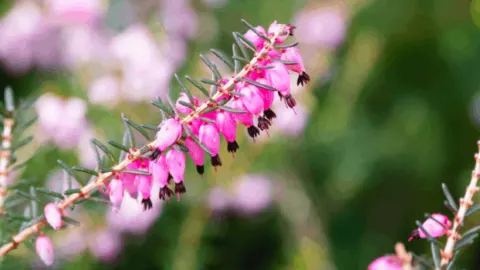The Common Heather plant, or Calluna vulgaris, is a species of flora that is sought after by many botanists.
They are well known for their beautiful foliage that grows in an arrangement of whorls that sport feather or scale-like leaves.
They are primarily found in moorlands and heathlands.
Most Calluna vulgaris owners tend to keep them outdoors since they tend to be a bit picky.
Don’t let that dismay you.
Raising a Heather plant indoors can be quite the treat!
Heather Plant Care
Use a soil mix of peat moss and compost and maintain a pH level of around 4 to 5.5. Provide at least 6 hours of direct sunlight. Water every week during growing season. Provide a temperature between 50-70 degrees F° (10 and 21 degrees C°). Keep the humidity between 40 to 60%.
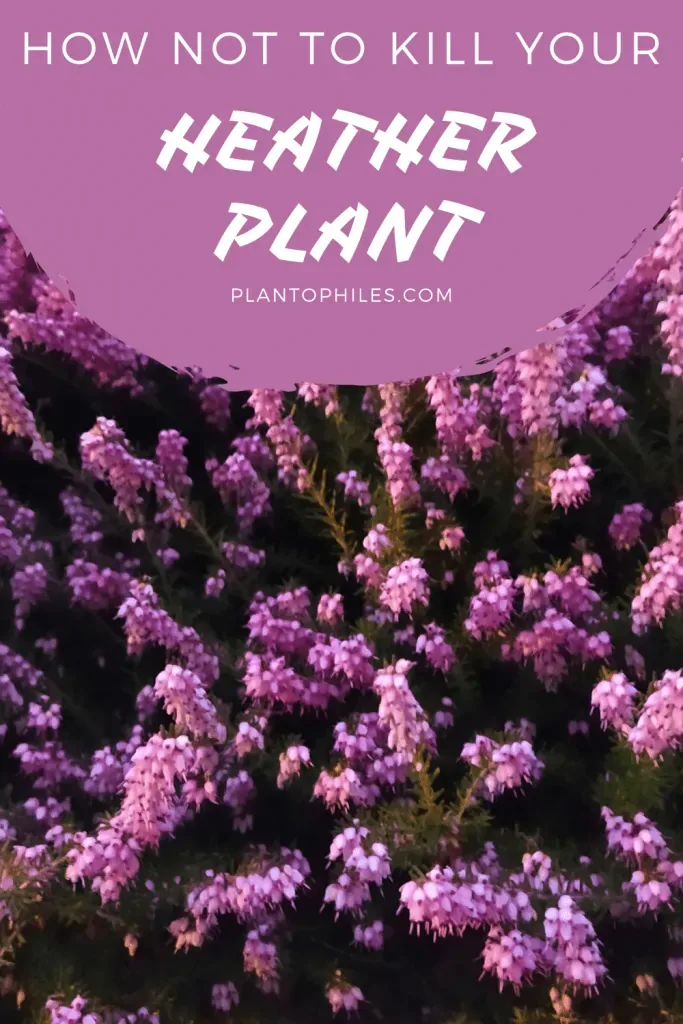
Heather Plant Care
Table of Contents
These plants are known for being fairly hardy when it comes to experiencing drought or cold temperatures.
Keeping them indoors may be easier in some regards as you don’t have to contend with these variables.
SOIL
Not all plants are sensitive in terms of overall pH levels. The Common Heather, on the other hand, is.
They have been known to prefer a pH level of around 4 to 5.5, meaning that they are avid lovers of acid.
Soil with organic materials such as peat moss or a mixture of compost can provide any missing nutrients. Loam soils are also good for this reason.
You may even want to consider adding fertilizer in an effort to increase the levels of nitrogen, potassium, and phosphorus that are lacking in acidic soil.
LIGHT
Calluna vulgaris is known for its small, scale-like leaves.
They aren’t particularly large, but they do make for it in color, sporting a deep green shade.
But in order to keep this vibrant foliage, you’ll have to pay close attention to how much light your plant receives.
Overall, these individuals need a good amount of sunlight. The more sun that they can get, the better!
Most plants don’t enjoy bright, direct sunlight.
The Heather plant, on the other hand, needs about six hours, or more, of full sun.
If your flora does not get the necessary light, the stems will become leggy and dull.
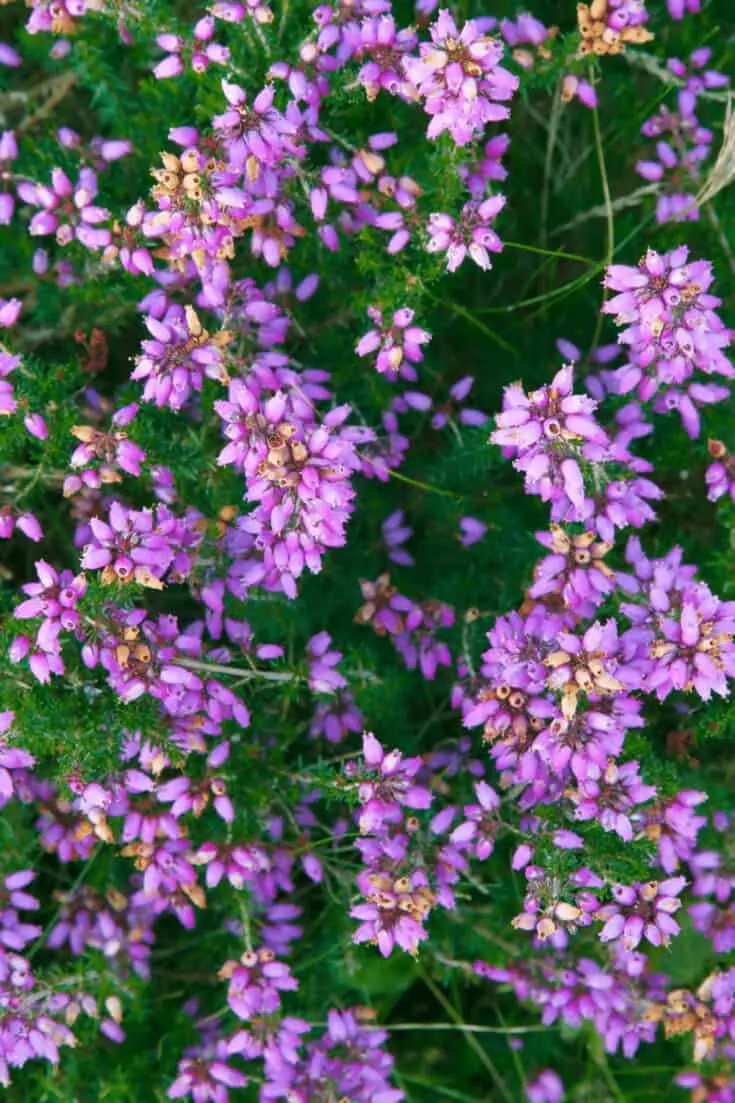
Heather Plants prefer at last 6 hours of direct sunlight per day
WATERING
Adult Heather plants only need about an inch or two of water in a week. The goal is to keep the soil fully saturated without being too soggy.
Root rot is a major problem for these plants. Letting your plant dry out can cause much worse problems where the flora dies away.
In case this happens, don’t stress out! They can be revived with enough patience and attention.
TEMPERATURE
The biggest takeaway for the temperature needs of a Heather plant is that they are relatively sensitive to temperature fluctuations.
Anything lower than -11 degrees Fahrenheit (-24 degrees Celsius) is detrimental to the plant’s overall health.
Fortunately, indoor plants won’t be subjected to such drops.
The best temperature for a seed to germinate is about 68 degrees Fahrenheit (20 degrees Celsius).
In general, you should try to keep the temperature in your home between 50-70 degrees Fahrenheit (10 and 21 degrees Celsius) for the Heather plant to thrive.
The evenings can be a bit cooler as long as they don’t reach freezing temps.

Heather Plants prefer temperatures between 50-70 degrees Fahrenheit (10 and 21 degrees Celsius)
HUMIDITY
The Heather plant isn’t a big fan of high humidity. They would rather get their moisture through watering, so humidity should be <50%.
Heather plants are known for being fairly tolerant when it comes to overall conditions, but humidity can be a different story.
In general, moorlands are not known for having high levels of humidity.
They tend to average around 30 to 50 percent, at the very most.
The leaves are extremely sensitive to having too much liquid on their surface.
The average household will have the right humidity. Just keep in mind that you don’t have to add a misting regimen.
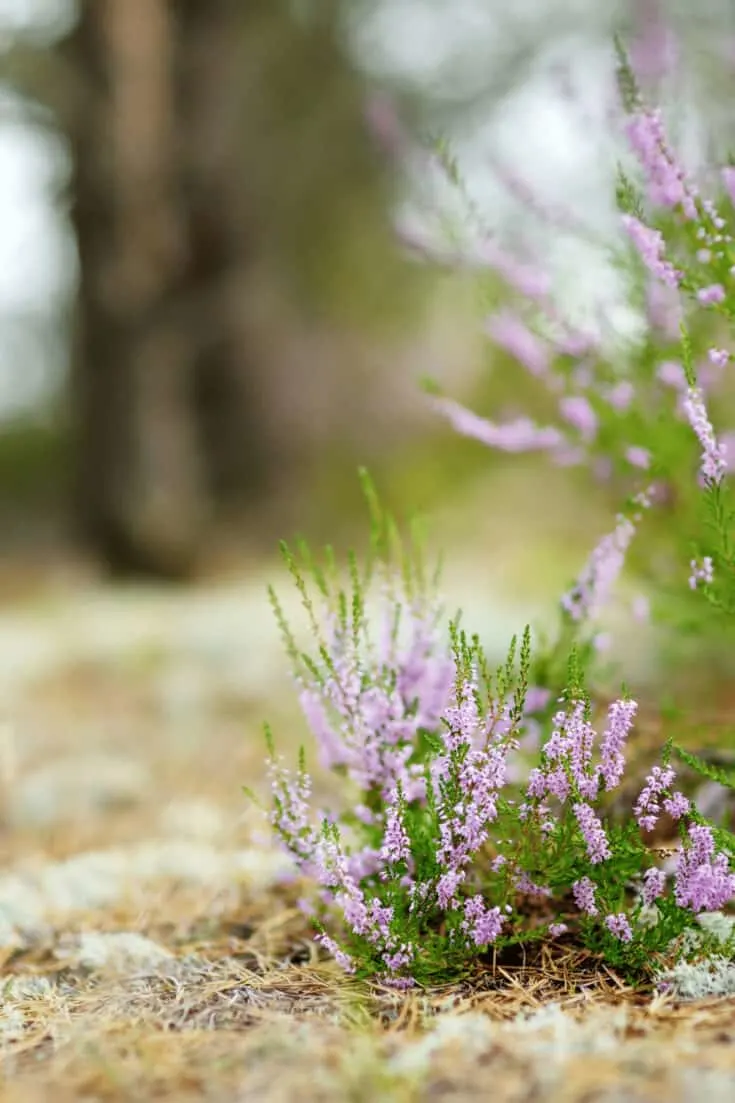
Heather Plants are not fond of high humidity. Keep humidity below 50%
FERTILIZER
The flowers found on a Common Heather plant are rather small compared to other indoor plants. They don’t tend to take much to grow, thus needing little to none concerning fertilizer.
If your plant seems to be having trouble, you can add a water-soluble solution in the winter and spring months.
This food should be specifically designed for acid-loving plants. Most fertilizers are too high in nutrients, thus stunting growth.
Nitrogen, out of all the nutrients you can add, is the most detrimental. Only add fertilizer if you are sure that it won’t harm your plant.
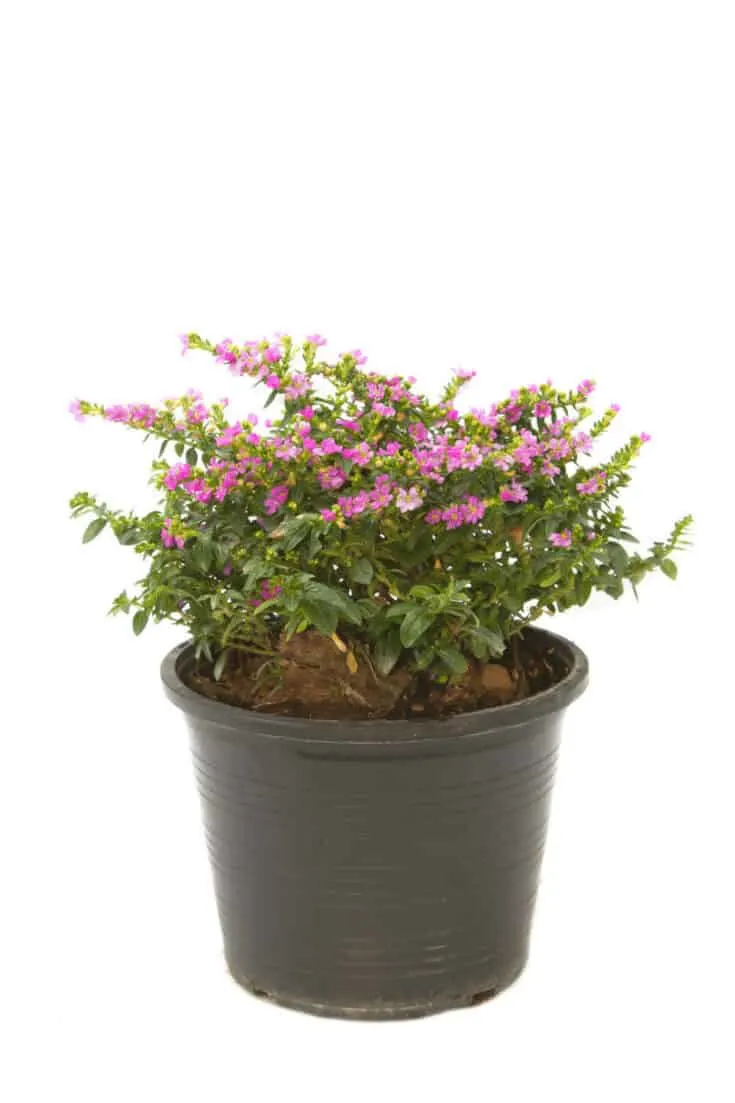
Heather Plants should not be fertilized or very little
PROPAGATION
These perennial shrubs are pretty easy to propagate. The only tedious aspect is that they take a bit longer to root than other flowering plants.
Most Heather plant owners will suggest that you propagate a Calluna vulgaris through either cutting or layering.
We will explore the steps involved in stem cutting later on in the article just in case you’re new to propagation!
GROWTH
The Heather plant isn’t known for its size, making them a great candidate for indoor houseplants. They average at around 2 feet in height.
These individuals spread out to a width of around 2 or 3 feet in width.
Being a shrub, they can be quite leggy if not taken care of.
If you have multiple planted in one area, we suggest that you have them spaced out by at least two feet.
This allows the plant to have proper air circulation.
They grow at a relatively quick rate and last for a few years.
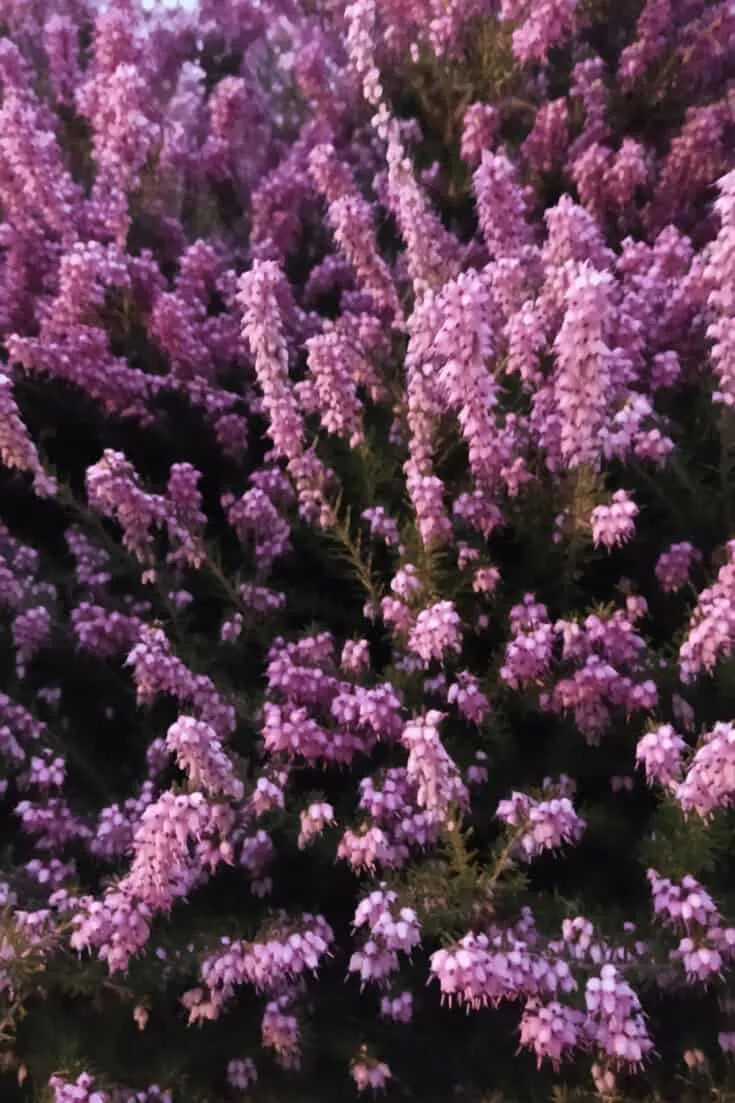
Heather Plants are not in the same family as lavender plants
POTTING
There may be a few reasons that hint at your plant needing to be transferred.
These can include cramped space, wrong soil, or needing to restore the individual and start over.
Regardless of the reason, you should expect to repot every two years.
The root system of a Common Heather plant is hardy making it much easier to transfer to a new container when the time comes.

The Common Heather Plant (Calluna vulgaris) is native to the Azores, Europe, Iceland and the Faroe Islands. It is the only species in the genus Calluna in the plant family Ericaceae.
COMMON HEATHER WATERING RITUAL
Once you have the right soil for a Heather plant, you’ll want to implement a regular watering schedule.
The roots tend to favor being consistently saturated, without the risk of becoming dried out. This will likely be about once a week.
This may not be the correct schedule depending on a number of factors such as the temperature of your house.
Frequently checking the soil for overall saturation is the best way to avoid drying out the roots.
The general rule is that the top six inches of soil should be kept damp. You can use your finger to accurately gauge whether this is true.
PROPAGATING YOUR COMMON HEATHER PLANT
As we mentioned earlier, the easiest methods of propagation for these shrubs is either through cutting or layering.
We feel as though stem cutting is the most straightforward and well-loved. We’ve provided the steps below!
PROPAGATION THROUGH STEM CUTTINGS
- Prepare a small pot with fresh soil that is acidic and holds organic material.
- Find a healthy stem that has consistently developed flowers and shoots, taking a three to four inch incision underneath a bud.
- Remove any dead or dying foliage with your fingers.
- Place the cuttings into the soil with about an inch between them.
- Water the cuttings thoroughly and proceed to cover them over with a clear bag. Continue to add water over time so that the soil does not dry out.
- Keep an eye out for new growth, which generally takes about a few weeks. Once this happens, you can transfer them to a larger pot, dividing the cuttings since there will be multiple in one yielding.
HEATHER PLANT PESTS AND DISEASES
There are quite a few plant enthusiasts who have found pests on their beloved Calluna vulgaris.
Most of the time, this happens when these individuals are kept in the garden.
That does not mean, however, that they are immune once placed indoors. A number of bugs and diseases can wreak havoc on these fragrant plants.
The bugs that typically attack these moorland inhabitants are spider mites and oyster shell scale insects.
Spider mites are generally shown through webbing and discoloration of the leaves. Regular dish soap mixed with water can be an easy way to rid your plant of these bugs.
Little white dots are usually a symptom of oyster shell scale. Insecticides and hosing down the leaves can rid your Heather plant of these.
Powdery mildew, and rot attacking the roots and stems are among the most common diseases found on Heather plants.
Most of these can be attacked by using fungicides or by washing your plant with water and soap. Just make sure that you look up measurements.
Too much soap can harm the foliage.
If you’re still worried about to look for in root rot, consider reading our article on Root Rot Treatment!
COMMON HEATHER PLANT WOES
Just as with caring for any living being, it’s important to watch for any signs that it is struggling.
Plants are known for leaving big clues. You just need to know how to read the signs.
Here are the most typical issues that you may experience with your Calluna vulgaris!
TELLTALE SIGN #1: BROWNING ON THE STEM
If you’ve noticed brown along the stem, chances are that the roots have been experiencing the same problem.
Browning is an indicator that your plant has too much water and not enough drainage.
Lay off watering your Heather plant for a few days and add drainage holes on the bottom of the container.
TELLTALE SIGN #2: YELLOWING FOLIAGE
Yellow foliage tends to be a result of dry air. This can lead to leaf scorch, especially when the leaf margins are brown.
The best remedy is to move your Heather plant to an area with more humidity.
Make sure that it is away from a spot with a draft.
We have an article strictly dedicated to this issue. You can find it here!
TELLTALE SIGN #3: WHITE SPOTS
White dots that show up on the leaves of a Common Heather plant mean that your plant has been infected with powdery mildew.
This form of the disease can be easy to tackle if found early on.
You’ll want to do this by hosing down the leaves. If that doesn’t work, invest in some insecticide.
TELLTALE SIGN #4: DROOPING OF LEAVES
You may unfortunately come across the drooping of foliage when it comes to your Heather plant.
You can assume that your plant needs more sun. Without the proper adjustments, the individual can die.
Place your plant into a spot that gets full sunlight. Remember that they need at least six hours of sunlight per day!
5 STEPS TO A HAPPY HEATHER PLANT
There’s plenty of information in this article. For new plant owners, it may be a lot to take in.
That’s why we’ve compiled the five most important steps for your Common Heather plant.
- Choose a soil that is more acidic, preferably between 4 to 5.5 for the pH level
- Keep the soil consistently saturated without allowing it to dry out
- The temperature should be kept between 10 and 21 degrees Celsius
- Only use fertilizer if you absolutely need to since this can damage your plant
- Try to keep the humidity within your house relatively low!
FREQUENTLY ASKED QUESTIONS ABOUT HEATHER PLANT CARE
Are Heather plants and Lavender the same thing?
Lavender plants are in a separate family from the Common Heather. They do share similar attributes such as small flowers and fragrant foliage.
Are Heather plants deer resistant?
Although not all that important for indoor houseplants, but if you wish to transfer them to your garden, you may be pleased to find that they are too acidic for deer.
Are Heather Plants poisonous to cats and dogs?
Heather plants do indeed have toxic properties that may result in discomfort when consumed by cats, dogs, or humans. We recommend keeping them out of range from small kids and pets.

Daniel has been a plant enthusiast for over 20 years. He owns hundreds of houseplants and prepares for the chili growing seasons yearly with great anticipation. His favorite plants are plant species in the Araceae family, such as Monstera, Philodendron, and Anthurium. He also loves gardening and is growing hot peppers, tomatoes, and many more vegetables.

